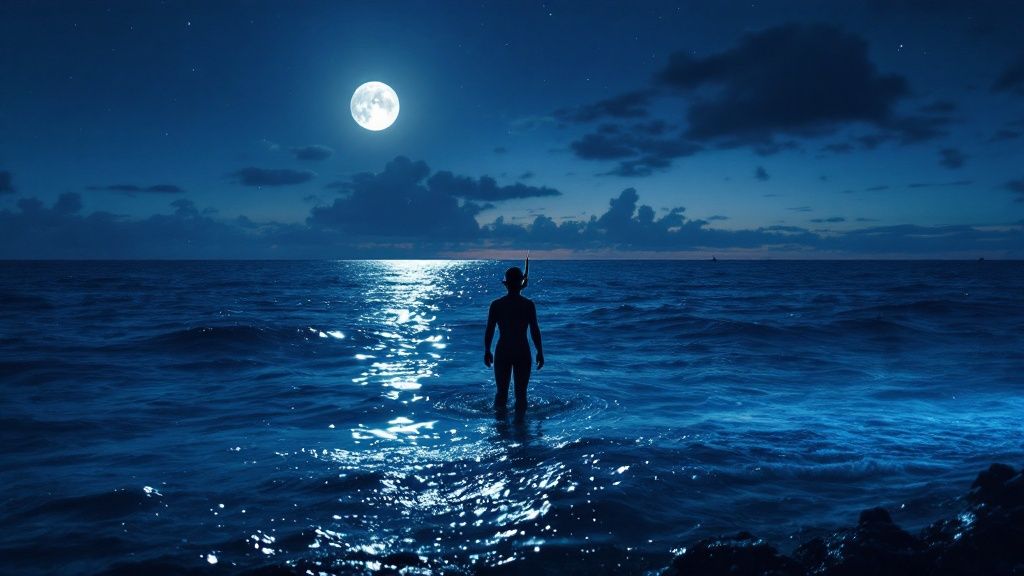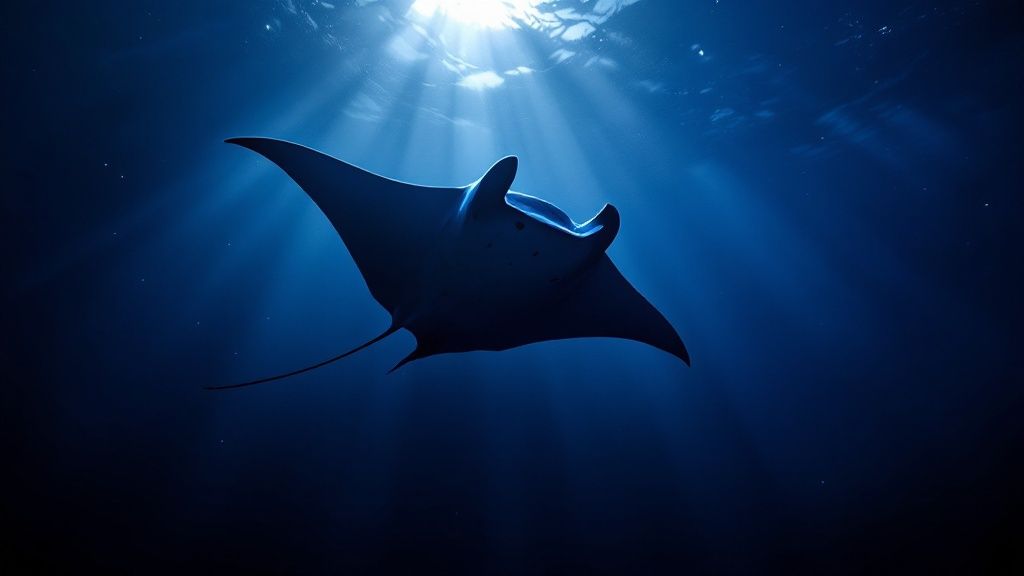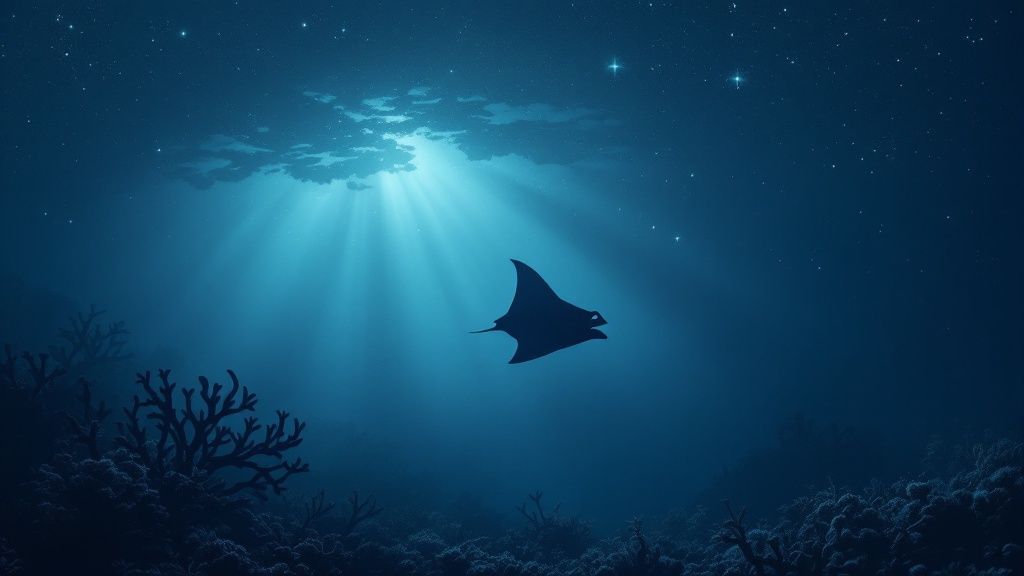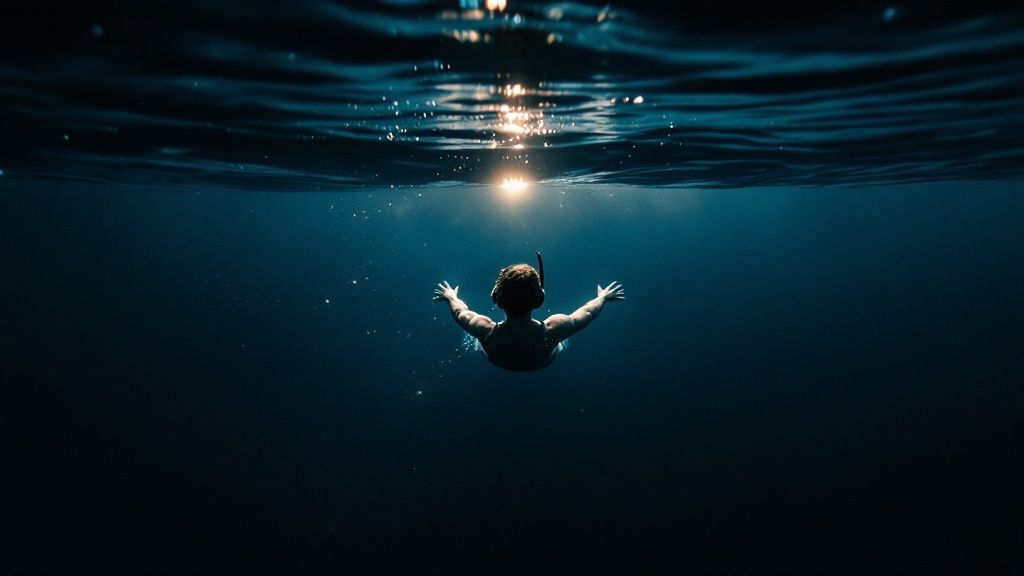night time manta ray snorkel kona: A Magical Dive
- Byron
- Apr 9
- 11 min read
The Mesmerizing World of Kona's Night Manta Rays

Imagine floating in the dark Pacific Ocean, the only light coming from soft underwater glows. Then, a graceful giant appears: a manta ray. Its wings, spanning up to 14 feet, glide effortlessly through the water. This is the magic of a Kona night manta ray snorkel. This special experience transforms travelers into awestruck ocean lovers, offering a close encounter with one of the ocean's most captivating creatures.
Why Kona? The Perfect Manta Ray Habitat
Kona's unique underwater environment makes it an ideal home for manta rays. Nutrient-rich currents attract massive amounts of plankton, their main food source. This plentiful food, along with the underwater topography, allows for regular manta ray sightings you won't find anywhere else.
Manta Village in Keauhou is known for its reliable manta ray activity, thanks to the thriving plankton. Other locations like Manta Heaven (near the airport) and Manta Point (Kohala Coast) further establish Kona as the spot for night manta ray snorkeling.
To help you understand the remarkable consistency of these encounters, let's take a look at some key statistics:
The following table presents key statistics about manta ray sightings and snorkeling activities in Kona to help visitors understand what to expect.
Statistic | Value | Significance |
|---|---|---|
Annual Snorkelers | 80,000 | Demonstrates the immense popularity of this activity. |
Sighting Success Rate | 80-90% | Highlights the high probability of seeing manta rays on a tour. |
Average Manta Ray Wingspan | 10+ feet | Underscores the impressive size of these gentle giants. |
These numbers paint a clear picture: Kona offers a truly special opportunity to connect with these magnificent creatures. For more details on planning your manta ray adventure, check out this helpful resource: Manta Ray Snorkeling Kona: Unforgettable Encounters
The Manta Ray Ballet: A Nighttime Spectacle
The magic of a Kona night manta ray snorkel lies in their unique feeding behavior. Drawn by the underwater lights from tour operators, the manta rays perform a captivating ballet as they feast on plankton.
This feeding frenzy, known as "barrel rolling" or "chain feeding," gives snorkelers an up-close view of these graceful giants. Imagine these creatures, sometimes with wingspans over 10 feet, doing acrobatic loops just inches from your mask. It's an experience that often moves visitors to tears.
Choosing Your Manta Ray Adventure
Many reputable tour operators offer Kona night manta ray snorkel experiences. Kona Honu Divers, Manta Ray Night Snorkel Hawaii, Kona Snorkel Trips and Captain Cook Snorkeling Tours are a few examples.
Each operator provides unique features and benefits, from small groups to specialized equipment. Choosing the right one can greatly enhance your experience. You can find more information here: Manta Ray Night Snorkel Hawaii Blog Categories. This mesmerizing experience is only the beginning of the wonders Kona offers.
Prime Times for Manta Ray Encounters

Want to experience the magic of a manta ray night snorkel in Kona? Timing is key. While sightings are generally consistent year-round (remember that 80-90% success rate?), certain times and conditions can make your encounter truly unforgettable. Understanding how the moon and seasons affect manta ray behavior and visibility is essential.
The Influence of the Moon
The moon significantly impacts your manta ray viewing experience. A bright moon allows more light to penetrate the water, which can sometimes diminish the effectiveness of the dive lights used to attract plankton. A darker sky, however, creates a beautiful contrast, making the manta rays appear even more dramatic against the backdrop. This is why nights near the new moon are especially favored for manta ray viewing.
Seasonal Variations
Manta rays grace Kona's waters year-round. However, the dry season, from April to October, typically offers calmer waters and increased visibility. But don't worry, even during the wetter months, incredible encounters are still frequent. The plankton these gentle giants feed on are always present, ensuring a consistent food source. This contributes to Kona's reliable manta ray population. Water temperatures also remain fairly constant throughout the year, making this a comfortable activity whenever you visit. Want to learn more? Check out more details on manta ray encounters.
The Importance of Experienced Guides
Experienced guides are essential for a successful manta ray night snorkel. They have a deep understanding of manta ray behavior, the best viewing spots, and ideal timing. These guides often schedule tours around sunset or after dark to optimize your chances of seeing these graceful creatures in action. They understand how to position snorkelers for optimal viewing while prioritizing both human and manta ray safety. They also adapt to changing weather conditions to ensure the best possible experience.
Making the Most of Your Adventure
Whether you're planning ahead or booking last minute, understanding these factors can greatly improve your manta ray night snorkel experience. Consider the moon phase and seasonal conditions. Most importantly, choose a reputable tour operator with experienced guides. Experts like Kona Honu Divers, Manta Ray Night Snorkel Hawaii, Kona Snorkel Trips and Captain Cook Snorkeling Tours understand the nuances of timing and location, turning a good experience into a truly magical one. By considering these factors, you'll maximize your chances of a breathtaking encounter with these gentle giants in their natural habitat, creating memories to last a lifetime.
Choosing Your Perfect Manta Ray Expedition

Planning a manta ray night snorkel in Kona? Not all tours are the same. Picking the right operator can make all the difference in your experience. This means looking closely at each company, from the boats and guides to how they approach sustainability. We've looked at four popular choices: Kona Honu Divers, Manta Ray Night Snorkel Hawaii, Kona Snorkel Trips, and Captain Cook Snorkeling Tours.
Key Factors To Consider
A perfect manta ray night snorkel adventure hinges on a few key things. Vessel comfort is a big one. A stable, spacious boat makes the trip to and from the snorkel site enjoyable. Expert guides are also essential. Their knowledge of manta ray behavior, the best viewing spots, and safety procedures is invaluable.
Group size matters too. Smaller groups often mean more personal attention from the guides and closer manta ray encounters. Finally, think about the operator's commitment to safety and sustainability. Reputable companies prioritize both your well-being and the protection of the manta rays and their habitat.
Comparing Kona’s Top Manta Ray Tour Operators
To help you compare, we've compiled a table summarizing key features of each tour operator:
To make choosing easier, here’s a comparison of the four operators:
Tour Operator | Price Range | Group Size | Trip Duration | Special Features | Departure Location |
|---|---|---|---|---|---|
$$ | Small | 2-3 hours | Focus on personalized experiences | Honokohau Harbor | |
$$ | Small | ~2 hours | Two tour times nightly, sunset & after dark | Keauhou Bay | |
$$ | Varies | ~2 hours | Multiple snorkel locations | Keauhou Bay | |
$$$ | Small to Medium | Varies | Offers various snorkeling and diving tours | Keauhou Bay |
This table offers a quick overview of price, group size, trip length, and special features to consider when booking.
Understanding The Nuances
While the table gives a general idea, it’s worth digging a little deeper. Kona Honu Divers, for instance, focuses on small groups and personalized experiences for a more intimate manta ray encounter. Manta Ray Night Snorkel Hawaii offers two nightly tour times – sunset and after dark – for different perspectives.
Kona Snorkel Trips visits multiple snorkel spots, increasing your chances of seeing a variety of marine life. Captain Cook Snorkeling Tours offers a wider selection of tours for all skill levels, from snorkeling to diving. The best choice depends on what you’re looking for. For more trip planning information, check out this Manta Ray Night Snorkel Hawaii Site Map.
Accessibility And Family-Friendliness
Accessibility is another important factor. Not all tours work for everyone. Some are better for strong swimmers, while others cater to those with limited swimming skills or families with children. Some operators provide flotation devices and extra help in the water. Be sure to ask about these options when booking to make sure the tour is a good fit for your group.
Real Experiences: Participant Feedback
Reading reviews from other snorkelers can offer valuable insights. Some praise Kona Honu Divers for their knowledgeable guides and personalized touch. Others appreciate the flexible departure times offered by Manta Ray Night Snorkel Hawaii.
Reviews of Kona Snorkel Trips frequently mention the multiple snorkel sites. Captain Cook Snorkeling Tours receives positive feedback for its professionalism and diverse tour options. Considering these real experiences alongside the other factors we’ve discussed will help you choose the perfect manta ray night snorkel adventure in Kona. This thoughtful approach will ensure a memorable encounter with these magnificent creatures, and you’ll know you’ve spent your time and money well. It's a bucket-list experience you'll want to do right!
Your Night Snorkel Journey: From Shore to Spectacle

So, you've booked your Kona manta ray night snorkel tour. What comes next? This guide breaks down the experience step by step, from arriving at the harbor to your magical encounter and return.
Check-In and Gear Up
Your adventure starts with check-in, typically at Keauhou Bay or Honokohau Harbor. You’ll meet your guides and receive your snorkeling gear, including a wetsuit, mask, snorkel, and fins. A safety briefing covers essential information, including manta ray etiquette. Some operators, like Kona Honu Divers, focus on small groups for a more personalized experience.
Boat Ride and Manta Ray Insights
Next, you’ll board the boat for a short ride to the snorkel site. Enjoy the anticipation as you relax and take in the ocean views. Guides continue the briefing, often sharing details about manta ray biology and behavior. For specifics on tour procedures, check out resources like Manta Ray Night Snorkel Hawaii or Captain Cook Snorkeling Tours.
The "Campfire" and the Glow
At the site, the magic unfolds. Operators deploy specialized light boards into the water, attracting plankton, the manta rays' main food source. Snorkelers enter the water, holding onto the boards in a circle, creating what’s known as the "campfire formation."
The Manta Ray Ballet Begins
As plankton gather, the manta rays arrive, performing an underwater ballet as they feed. Using their cephalic fins to funnel plankton, they sometimes execute barrel rolls or engage in chain feeding, following one another in a continuous loop. Witnessing their majestic wingspans, reaching up to 14 feet for reef mantas, is breathtaking.
Respecting the Gentle Giants
This close encounter is a highlight of any Kona manta ray night snorkel. Remember the cultural and ecological significance of these creatures. They are essential to Hawaiian folklore and cultural heritage. The local population is small, estimated at about 130 individuals. Learn more about manta rays in Hawai’i.
Underwater Photography Tips
Capturing the moment is tempting, but prioritize enjoying the experience. If you bring an underwater camera, use a red filter to enhance colors in the blue light. Disable your flash, as it can startle the manta rays. Kona Snorkel Trips and other operators often offer photography tips on their websites.
Managing Your Excitement
Feeling excited, or even a little anxious, is normal, especially in the dark water. Focus on your breathing and trust your guides. They prioritize your safety and enhance your experience.
Return and Reflection
After 20-30 minutes in the water, you'll return to the boat and head back to shore. Reflect on the incredible encounter and share your experience. The memories of your Kona manta ray night snorkel adventure will last a lifetime.
Essential Prep for Your Manta Ray Encounter
Getting ready for your nighttime manta ray snorkel adventure in Kona is key to having an amazing time. It's more than just grabbing your gear; it's about preparing yourself both mentally and physically for a special encounter with these gentle giants. We'll cover everything from what to eat beforehand to how to handle any pre-trip jitters.
Gearing Up for Success
Packing the right items can really boost your comfort and overall enjoyment. A light sweater or jacket is a good idea for the boat ride back, as it can get cool after being in the water. Don't forget a towel and a dry change of clothes. While tour operators like Captain Cook Snorkeling Tours often provide snorkeling equipment, bringing your own, if you have it, can ensure a better fit.
Prepping your gear beforehand can also make a difference. Applying anti-fog solution to your mask is vital for clear underwater vision. Test it out in a sink before you go to make sure it's working properly. For more advice on gear and getting ready, check out our guide on Manta Ray encounters. This will help you make sure you don't miss a single moment.
Food, Medication, and Seasickness
What you eat before your nighttime manta ray snorkel tour can greatly affect your comfort. Steer clear of heavy, greasy meals that might upset your stomach. Choose light, easily digestible snacks instead. If you're prone to motion sickness, taking precautions is a good idea. Non-drowsy motion sickness medication or patches can be incredibly helpful. Dramamine, a common medication, can be surprisingly effective in preventing nausea.
Managing Expectations and Anxieties
It's perfectly normal to feel a little anxious about snorkeling in open water at night. Understanding what to expect and trusting your guides can help ease any worries. Reputable operators like Manta Ray Night Snorkel Hawaii and Kona Honu Divers make safety a top priority. Their guides are experienced and well-trained in managing both human and manta ray interactions.
Photography Tips for Low-Light Conditions
Capturing those amazing manta ray moments is tempting, but remember to prioritize enjoying the experience firsthand. If you do bring a camera, remember that low-light conditions need special settings. A red filter helps correct for the blue light underwater. Most importantly, turn off your flash, as it can disorient and bother the manta rays.
Special Considerations for Families and Less Experienced Swimmers
If you're with children or less confident swimmers, choosing the right tour operator is especially important. Operators like Kona Snorkel Trips cater to all experience levels, offering extra support and flotation devices as needed. This means that everyone, no matter their swimming ability, can confidently participate in this incredible experience. By following these tips, you'll be well-prepared to embrace the magic of your manta ray encounter.
Protecting Kona's Magnificent Manta Population
Your nighttime manta ray snorkel Kona adventure is more than just a personal memory. It's a vital contribution to ongoing conservation efforts for these vulnerable creatures. Every tour plays a part in their protection. This section explores how your participation directly helps these gentle giants. You might be interested in: More about blog categories.
Citizen Science: How Your Photos Contribute to Research
Every manta ray has a unique belly pattern, similar to a human fingerprint. Researchers use these patterns to identify and track individual mantas. These patterns are often captured in photographs taken by tour participants like you.
This information is invaluable for understanding population health, migration patterns, and reproductive success. Analyzing photos allows scientists to track individual manta movements over time. They can also monitor population growth and identify potential threats.
The Economic Impact of Manta Ray Tourism
Manta ray tourism has significantly boosted Kona's economy, offering a sustainable alternative to traditional fishing. This shift has changed local perspectives on marine conservation.
The community now recognizes the value of protecting these animals for both ecological and economic reasons. Revenue from nighttime manta ray snorkel Kona tours supports local businesses and jobs, further encouraging conservation.
Science-Backed Regulations: Balancing Tourism and Conservation
Strict regulations are essential for balancing tourism with the long-term well-being of the manta ray population. These include maintaining safe viewing distances and following specific behavioral guidelines.
This careful balance minimizes disruptions to the manta rays' natural behavior and feeding patterns. For example, tour operators must maintain a specific distance from the mantas and avoid startling or distressing them.
How Your Tour Fees Support Conservation
Your nighttime manta ray snorkel Kona tour fees directly support vital research and habitat protection. This means your participation makes a tangible contribution to conserving these magnificent creatures and their environment.
These funds also support educational programs that raise awareness about the importance of manta ray conservation.
Becoming an Ocean Advocate: Beyond Your Kona Vacation
Your involvement in manta ray conservation doesn't end with your Kona vacation. Educating yourself about the threats facing manta rays globally and supporting dedicated organizations is crucial.
This could involve donating to conservation groups, advocating for stricter fishing regulations, or simply sharing your knowledge. You can support organizations like the Manta Pacific Research Foundation. Participating in citizen science initiatives can also contribute to ongoing research. By becoming an informed ocean advocate, you can help ensure these animals thrive for future generations.
Book Your Unforgettable Manta Ray Adventure Today!
Experience the magic of a nighttime manta ray snorkel in Kona and contribute to their conservation. Book your tour today with Manta Ray Night Snorkel Kona Hawaii Tours and make unforgettable memories while supporting a vital cause. We offer two distinct tour times nightly for all ages and experience levels. Join us for an intimate, educational, and awe-inspiring encounter with these gentle giants.
Comments